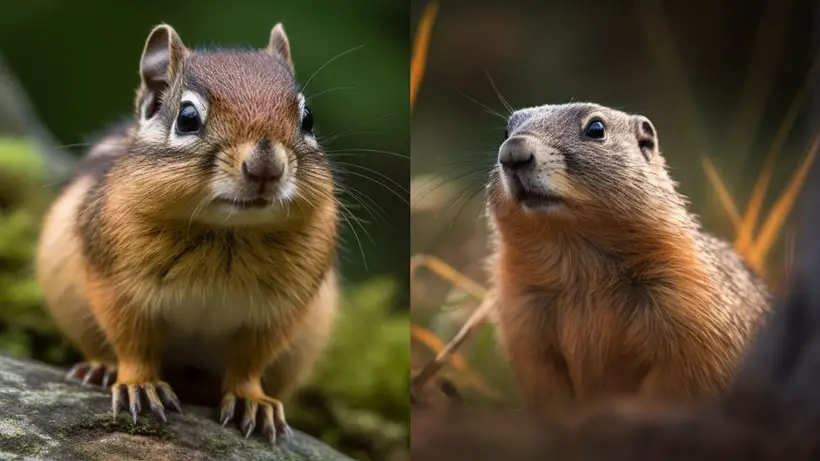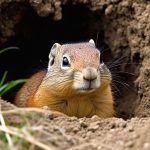Chipmunk Vs. Gopher: What’s The Difference?
Chipmunks and gophers are two small rodents found in different parts of North and Central America and parts of Asia(chipmunk). Although they have some similarities, these creatures are quite different from each other in many ways.
Chipmunks are known for their small size and striped fur, while gophers are known for their stocky build and short, furry tails. Aside from their physical differences, chipmunks and gophers also differ in their behavior and habitat preferences.
These rodents are two fascinating species that have adapted to survive in their unique environments. By understanding the differences between a chipmunk vs. gopher, you can better appreciate how to identify and control these pests. Also, you can prevent them from harming your garden.
Continue reading to learn the differences between chipmunks and gophers, including their physical characteristics, behavior, habitat preferences, and impact on gardens and lawns.
Differences Between Chipmunk Vs. Gopher: An Overview

While these rodents may look similar at first glance, several key differences exist in their physical characteristics, behavior, and habitat preferences. Before going in-depth discussion, here is a table below to show you the basic differences between these two rodents.
| Characteristic | Chipmunks | Gophers |
|---|---|---|
| Size and Weight | 7-10 inches, 1-5 ounces | Up to 15 inches, up to 2 pounds |
| Fur Color | Striped pattern (brown, gray, black) | Single color (light brown to dark black) |
| Tail Type | Long and bushy | Short and stubby |
| Burrowing Habits | Shallow burrows, small tunnels for foraging | Elaborate burrow systems for living and storing food |
1. Physical Characteristics
Chipmunks and gophers are both small, burrowing rodents, but they have distinct physical characteristics that set them apart. Here is a table showing all the physical differences between these rodents.

Size and Weight
One of the most noticeable differences between these pests is their size.
Chipmunks are generally smaller than gophers, with the average one measuring between 7 and 10 inches long and weighing between 1 and 5 ounces.
Conversely, gophers can grow much larger, with some species measuring up to 15 inches long and weighing up to 2 pounds.
Fur Color
Another way to tell the difference between these garden pests is by their fur color. Chipmunks have a distinctive striped pattern on their fur, with alternating light and dark stripes running down their back. These stripes can be brown, gray, black, or a combination of these colors.
In contrast, gophers have fur that is usually a single color, with shades ranging from light brown to dark black.
Tail Type
These rodents also have different types of tails. Chipmunks have long, bushy tails that are often used to help them balance when climbing trees or jumping from branch to branch.
Gophers, on the other hand, have short, stubby tails that are not very useful for balance. Instead, they use their powerful front legs and sharp claws to dig tunnels and burrows underground.
Burrowing Habits
Both backyard pests are known for their burrowing habits, but they have different approaches to digging their tunnels and burrows.

Chipmunks are solitary animals that typically dig shallow burrows in the ground, often near trees or rocks.
These burrows usually have a single entrance and are used for sleeping, storing food, and hiding from predators. They also dig small tunnels under the ground to help them forage for food, such as nuts, seeds, and berries.
Even though gophers are solitary animals, their burrowing system is completely different.
Gopher burrow systems are very elaborate, consisting of dozens of interconnected tunnels and chambers. These burrows are used for sleeping, breeding, storing food, and protection from predators.
2. Behavioral Differences
In addition to their physical differences, these rodents have distinct behavioral differences. They include the following:
Social Behaviors and Communication Methods
Chipmunks are more social and often live in small groups. They communicate with each other using a variety of vocalizations, including chirps, trills, and squeaks. These vocalizations help them to warn each other of danger, establish territory boundaries, and locate food sources.

Gophers are primarily solitary animals, although they may live in small family groups. They communicate with each other using a variety of methods, including scent marking, body postures, and vocalizations.
They also use their sense of touch to communicate, as they have sensitive whiskers that can detect vibrations in the soil.
Foraging and Caching Behaviors
These backyard pests have different foraging and caching behaviors. Chipmunks are omnivorous, and their diet includes nuts, seeds, fruits, and insects. They are also known for their caching behavior, storing food in their burrows for later consumption.
Conversely, gophers are herbivorous and feed primarily on roots, bulbs, and tubers. They also store food in their burrows for later consumption, but their food caches are much larger.

Feeding Habits
Chipmunk feeding habits differ from those of gophers. This difference largely influences their preferred habitats.
After all, they are diurnal, which means they are active during the day. They forage for food above ground and often run along logs, fences, and other structures. They are also known to steal food from bird feeders.
Gophers, on the other hand, are primarily nocturnal, even though they can have diurnal tendencies. They forage for food underground, where they can safely dig up roots and tubers without being seen by predators. They are also known to cause damage to crops and gardens due to their feeding habits.
3. Habitat Preferences
Chipmunks and gophers have different habitat preferences, which can influence where they are found and how they interact with their environment. Here are the habitat preferences of these garden pests.

Types of Environments
Gophers prefer open areas with soft, moist soil, such as grasslands, meadows, and agricultural fields. They prefer areas with plenty of vegetation to feed on and areas with ample space to dig their burrows.
Alternatively, chipmunks prefer wooded areas and forest edges, where they can find cover and food sources. They also like living near water sources like streams or ponds.
Geographic Distribution
These rodents have different geographic distributions, with chipmunks found primarily in North America, from Alaska to Mexico. Several chipmunk species exist, including the eastern, western, and yellow-pine chipmunks.
Some species of chipmunks can be found in some parts of China, Japan, and Korea. They also can be found in small numbers in New Zealand and Europe.
On the other hand, gophers are found primarily in North and Central America. Several gopher species exist, including the pocket, the plains pocket, and the northern pocket gophers.
Depending on their preferences, these garden pests are found in various habitats within their respective ranges.

Impact of Human Activity
Human activity can significantly impact the habitats of these backyard pests. For example, converting natural habitats into agricultural or urban areas can reduce the available habitat for both species. Gophers can also cause damage to crops and gardens, which can lead to conflicts with humans.
In some cases, human activity can also provide opportunities for chipmunks and gophers to thrive. For example, chipmunks are often attracted to bird feeders, which can provide a reliable food source. Gophers can also benefit from human activity, as the soft soil types in agricultural fields can be ideal for digging burrows.
If you’re curious about gophers and want to learn more, you might be interested in our articles on whether gophers are rodents and how to set a gopher trap. Our piece on whether gophers are rodents explores their classification in the animal kingdom, while our article on how to set a gopher trap provides practical advice on how to catch these pests.FAQs
Here are a few more additional questions you might be asking about chipmunk vs. gopher.
Q1: Can chipmunks and gophers interbreed?
No, chipmunks and gophers cannot interbreed. They are two separate species of rodents with different genetic makeup.
Q2: Are chipmunks and gophers harmful to humans?
Generally, these pests are not detrimental to humans. However, they can cause damage to gardens and lawns, which can be a nuisance for homeowners and gardeners. That is why most people incorporate different baiting methods to control them.
Q3: How do chipmunks and gophers differ in their impact on gardens and lawns?
Chipmunks are known for digging small holes in gardens and lawns for food. On the other hand, gophers can cause extensive damage to lawns and gardens with their extensive burrowing habits.
Conclusion
Understanding the differences between chipmunks and gophers is essential for effective pest control and wildlife management. While both species may look similar at first glance, they exhibit significant differences in physical characteristics, burrowing habits, behaviors, and habitat preferences.
As a homeowner or gardener, you can take steps to prevent chipmunk and gopher damage in your gardens and lawns by using pest prevention methods that are safe and effective for both humans and wildlife.
Doing further research into chipmunks’ and gophers’ behavior and habitat preferences can help you better understand and avoid these backyard pests.




